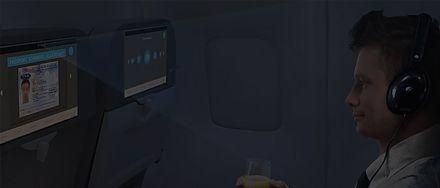360° BIOMETRIC SOFTWARE FOR AVIATION
“The use of biometrics to personalize an experience is largely untapped, particularly in the realm of aviation where many technologies are still running on analog.”
Written by Luis Paradela|Posted on July 21, 2020

THE CHALLENGE
Create a set of interactive biometric sensor applications to educate the aviation industry on how technology can personalize the passenger travel experience, customer services, and in-flight entertainment.
THE OUTCOME
The Bluetooth-based mobile application was the first of its kind on the market. The overall product has not only been a success for the client, but a breakthrough for the industry.
AccelOne was contracted to create a set of biometric sensor applications to be showcased by an industry-leading company at the annual Airline Passenger Experience Association (APEX), an invite-only event for aviation professionals.
The event hosts thousands of industry professionals, over 100 airlines, 150 vendors, and features technology, products, and services for the aviation industry. The goal was to create interactive applications to help educate the industry on how biometric technology such as facial, IRIS, voice, palm-vein recognition, and head tracking could be used to personalize the passenger travel experience, customer service, in-flight entertainment, and in-airport and in-flight services.
THE NEED
In order for the company to demonstrate how biometric technologies could be used for business reasons beyond their current uses, the company needed to erect a large, futuristic, passenger experience exhibit at the APEX event. This exhibit featured a series of stations where visitors could interact with the biometric-enabled applications on Microsoft Surface Pros in a simulated travel environment.
When users approached the exhibit, they were first directed to the Biometric Registration station, where they would undergo an initial biometric scan and questionnaire to create a personalized profile. This profile was then used to customize their experience as they moved throughout the exhibit and interacted with the 360° Audio/Visual Experience and Biometric Education stations.
AccelOne was tasked with developing the applications for these three stations and integrating them with the biometric sensor technology. The greatest challenge that they faced on this project was integrating all elements of the project with one another, ensuring that they all worked together seamlessly all on time. The biosensors, which were provided by a 3rd party vendor, needed to seamlessly work with the application technology developed by AccelOne, and the databases needed to be easily accessed throughout.
THE PROJECT
To begin the custom application development work on this project, a team of software engineers was assembled.
Because of the tight timeline, and the need for the applications to integrate with one another, the team decided to divide the development into three phases based on the three separate applications. This ensured the complete development and delivery of each application before moving onto the next.
Phase 1: Biometric Registration
For the first development phase, the team focused their efforts on the Biometric Registration station application. This station needed an application that would create a unique visitor profile based on a series of questions to establish personal preferences and IRIS + facial scan data.
IRIS biometrics are acquired using a camera that takes a detailed greyscale photo of the eye. The image of the eye is segmented so that only the iris, the textured and colored part of the eye that surrounds the pupil, remains. An algorithm converts the IRIS image into a template that resembles a 2D barcode, and another algorithm compares the template with others to find a match.
The Facial biometric system uses a camera to capture a picture of the face. Distinguishing physical features of the face, such as the eyes, eyebrow, forehead, nose, chin, cheekbones, mouth, and ears are identified, and their relative positions calculated.
The biometric device used to capture the data for this application used a SOAP Web Service and Ethernet connection. AccelOne integrated the IRIS scanning hardware and APIs, developed the personal profile application, and integrated with the backend databases that hosted the IRIS capture image and personal information. Because each database record was anonymized, database efficacy was critical, as this information would be used by several 3rd parties throughout the exhibits.
Phase 2: Biometric Education
Next, the team began the development of the Biometric Education application. When visitors approached this station, they were automatically “recognized” by the station based on their IRIS+facial data collected in the previous station, and invited to interact. The application walked them through the different biometric technologies and educated them on why and how the application was able to recognize them. They also were provided information on other biometric technologies, including Fingerprint Authentication and Voice Recognition.
Phase 3: 360° Audio/Visual Experience
For the third and final phase, the team developed the Experience station application. The purpose of this station was to immerse the visitor into a simulated travel environment where biometric data could be combined with high-quality digital content and head-tracking technology to enhance their in-flight experience.
When users approached this station, which featured multiple large display screens arranged in a 360° fashion, they were recognized and their preferences recalled by the application. They were then immersed in a high definition, 3D, Dolby surround-sound experience according to their preferences (e.g. beach, city, jungle, travel, rain, etc.). Key features of this experience included:
- Auto-shifting of the display to maintain it in front of where the user was looking
- Visitor capacity to control the audio/visual content based on their facial and head positions
- Voice recognition technology to adjust sound volume or pause an experience
- Language translation to improve interactions between passengers and flight-crews
THE RESULTS
Despite the many challenges that the team faced due to limited time, resources, and assets, they worked with exceptionally high speed, precision, and creativity in order to deliver the fully-functional applications in time for the event.
In just four weeks, they developed, integrated, and delivered the three applications. The applications were installed at the stations several hours prior to the event and the team continued to provide technical support throughout the event.
The feedback from the visitors and client was overwhelmingly positive, many users referenced the high quality of the applications and the unique way in which they were integrated with the biometric technology and applied to the aviation industry.

Luis Paradela
Chief Development Officer
Co-Founder
Buenos Aires
View profile